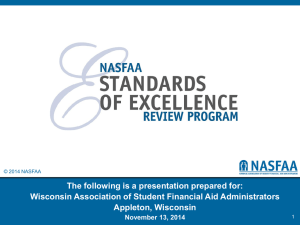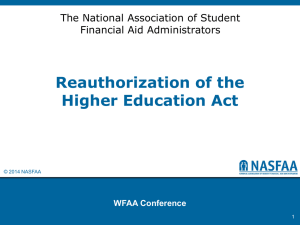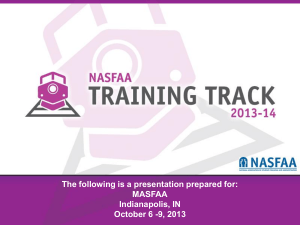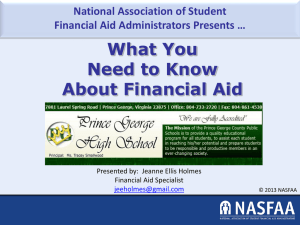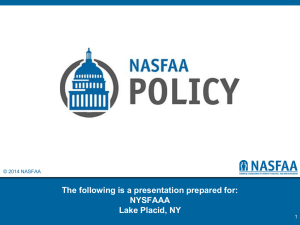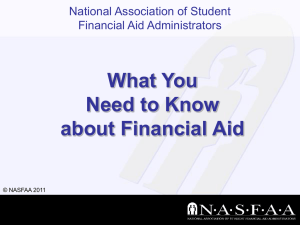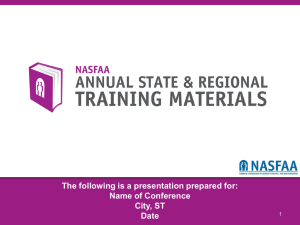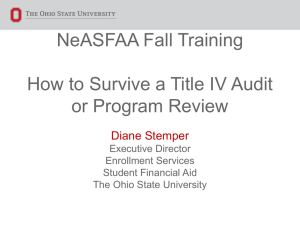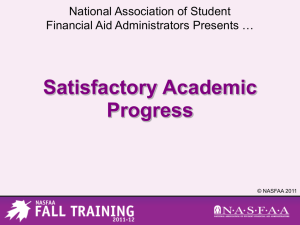Using NASFAA Tools to Ensure Title IV Compliance
advertisement
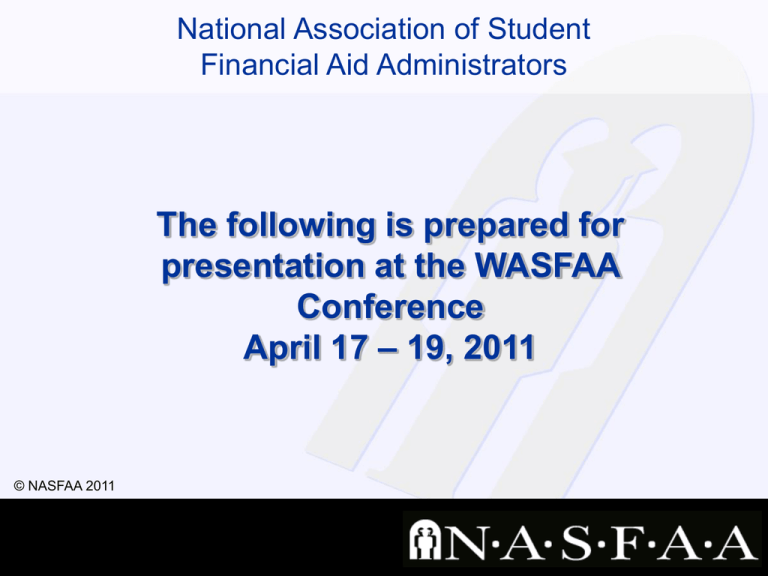
National Association of Student Financial Aid Administrators The following is prepared for presentation at the WASFAA Conference April 17 – 19, 2011 © NASFAA 2011 National Association of Student Financial Aid Administrators Using NASFAA Tools to Ensure Title IV Compliance Eunice Powell Senior Training Specialist Division of Training & Regulatory Assistance © NASFAA 2011 Types of Evaluations • Audits • Self Evaluation • Peer Evaluation • Program Reviews © NASFAA 2011 Slide 3 Evaluation Goal Institution must be administratively capable and financially responsible • On-going informal activity • Formal, thorough review of all aspects of operations • Routine reports © NASFAA 2011 Slide 4 NASFAA’s Self-Evaluation Guide © NASFAA 2011 Slide 5 What is the NASFAA Self-Evaluation Guide? • In-house evaluation tool for Title IV and HHS programs • Describes majority of requirements • Includes good practices © NASFAA 2011 Slide 6 What is the NASFAA Self-Evaluation Guide? • Contains regulatory citations & other references • Questions designed to easily identify areas of noncompliance • Interactive form fields © NASFAA 2011 Slide 7 Purpose and Applicability • Designed as an in-house assessment tool to evaluate efficiency and effectiveness • Contains typical program review and compliance audit questions © NASFAA 2011 Slide 8 Use Self-Evaluation Guide to: • Prepare for audit and program reviews • Affirm and/or revise financial aid operations, policies, and procedures • Provide outline for policies and procedures manual © NASFAA 2011 Slide 9 Use Self-Evaluation Guide to: • Train staff • Convey magnitude and complexity of financial aid administration to others • Document need for resources, staffing, and physical accommodations © NASFAA 2011 Slide 10 Use Self-Evaluation Guide to: • Prepare reports • Determine progress towards achieving goals for improvement • Preliminary evaluation to target areas for a formal review © NASFAA 2011 Slide 11 Self-Evaluation Guide Topics Covered The Guide is divided into 4 major parts: I. Institutional Responsibilities II. Administration of Title IV Federal Aid Programs III. Administration of Title VII and Title VIII Health Professions Programs IV. Appendices © NASFAA 2011 Slide 12 How to Complete the Guide • Guide is in interactive Q & A format • “Yes” means requirement met • “No” means follow-up needed • “N/A” means not applicable to the institution © NASFAA 2011 Slide 13 How to Complete the Guide © NASFAA 2011 Slide 14 New Features • Most recent additions: – Satisfactory Academic Progress – Institutional Requirements Related to Education Loans • Includes changes mandated by: – HEOA – ECASLA – October 2009 Final Rule Packages © NASFAA 2011 Slide 15 Who Should Complete the Guide? All offices that have activities that directly or indirectly impact financial aid programs should be involved © NASFAA 2011 Slide 16 How Do I Get the Self-Evaluation Guide? • Free membership benefit • Twenty-sixth edition • Twenty-fifth edition • Available on NASFAA website under Professional Practice Tools © NASFAA 2011 Slide 17 NASFAA’s Standards of Excellence Review Program © NASFAA 2011 Slide 18 What is the SOE Program? • Voluntary appraisal of financial aid operations • Assesses strengths and weaknesses • Makes recommendations to improve Title IV operations and customer service • Comprised of a team of your peers © NASFAA 2011 Slide 19 What is a Peer Review? • Financial aid administrators who have “been there and done that” • Not affiliated with your institution – More likely to recognize issues – Objective – Fresh perspective © NASFAA 2011 Slide 20 What Areas Are Covered in a Review? • Program compliance, operations, and delivery • Systems, automation, and technology utilization • Student service and satisfaction • Human resources and facilities © NASFAA 2011 Slide 21 SOE Contact Information For a quote or more information contact: Kenneth McGhee Program Coordinator 202-785-0543 excellence@nasfaa.org mcgheek@nasfaa.org © NASFAA 2011 Slide 22 NASFAA Policies & Procedures Tools © NASFAA 2011 Slide 23 NASFAA Policies & Procedures Tools • Toolbox with all the user-friendly tools you need to create and maintain an electronic policies and procedures manual • Benefit of NASFAA membership © NASFAA 2011 Slide 24 What’s in the Toolbox? • Tools for formatting, implementing, and evaluating policies and procedures • Regulatory Resources Guide containing: – Explicit and implied regulatory requirements – Areas where schools have implementation options © NASFAA 2011 Slide 25 What’s in the Toolbox? • Tips for formatting your P&P manual – Page format samples – Style decisions – Master tracking document • Guidance for reading and interpreting statutes and regulations © NASFAA 2011 Slide 26 What’s in the Toolbox? Electronic P&P manual templates: • Full version with comprehensive detail, including citations and references • “Shell” version—a pared-down outline of full version © NASFAA 2011 Slide 27 Template Features • Electronic shared-file, network and Internet capability • Descriptions of sections required or implied by law or regulation © NASFAA 2011 Slide 28 Manual Template Sections 1: Manual Introduction 9: Awarding & Packaging 2: Administrative Organization & Office Management 10: Professional Judgment 3: Financial Aid Programs 12: Satisfactory Progress 4: Institutional Requirements Related to Student Loans 13: Return of Title IV Funds 5: Student Consumer Information 15: Fraud 11: Disbursements 14: Institutional Refunds 6: Applications & Forms 16: Audits 7: File Review 17: Reserved 8: Student Budgets 18: Appendices © NASFAA 2011 Slide 29 Template Features Click-and-type functionality to easily add your school’s information © NASFAA 2011 Slide 30 Where Can I Find the Tools? Under Professional Practice Tools on the NASFAA website © NASFAA 2011 Slide 31 NASFAA Guide to Adding New Academic Programs and Locations © NASFAA 2011 Slide 32 Adding New Programs and Locations • Highlights major areas schools should review when: – Establishing new academic programs – Adding locations • Notes institutional eligibility and program eligibility considerations © NASFAA 2011 Slide 33 Adding New Programs and Locations • Lists regulatory and statutory citations for each area reviewed • Provides related NASFAA & Department of Education (ED) resources for further guidance © NASFAA 2011 Slide 34 Where Can I Find the Checklist? Under Professional Practice Tools on the NASFAA Website © NASFAA 2011 Slide 35 NASFAA’s Using Federal Tax Returns in Need Analysis © NASFAA 2011 Slide 36 Using Federal Tax Returns in Need Analysis • Reference tool on how to use federal income tax returns, forms & schedules for: – Verification – Need analysis • Updated annually by NASFAA © NASFAA 2011 Slide 37 Using Federal Tax Returns in Need Analysis • Cross-references FAFSA line items to tax returns, W-2 forms and schedules • Describes commonly used tax forms • Highlights use of W-2 forms for verifying certain taxable and untaxed income • Contains Guide to Implied Income and Assets © NASFAA 2011 Slide 38 Forms and Schedules Comparison Sample 2010 Federal Tax Forms and Schedules Comparison © NASFAA 2011 Slide 39 Where Can I Find It? Under Professional Practice Tools on the NASFAA Website © NASFAA 2011 Slide 40 NASFAA Monographs © NASFAA 2011 Slide 41 NASFAA Monographs • Provide practical information for student financial aid professionals • Developed primarily by practicing financial aid administrators and other NASFAA colleagues © NASFAA 2011 Slide 42 NASFAA Monographs—Topics 1. Developing Lender Lists 2. Professional Judgment 3. Cost of Attendance 4. Common Data Set © NASFAA 2011 Slide 43 NASFAA Monographs—Topics 5. Federal Budget Process 6. Satisfactory Academic Progress 7. Research Tools, Tips & Resources © NASFAA 2011 Slide 44 NASFAA Monographs Under Publications on the NASFAA website © NASFAA 2011 Slide 45 © NASFAA 2011 Slide 46 © NASFAA 2011 Slide 47
